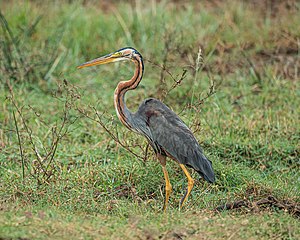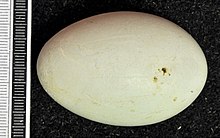Purple heron
| Purple heron | ||||||||||||
|---|---|---|---|---|---|---|---|---|---|---|---|---|

Purple Heron ( Ardea purpurea ) |
||||||||||||
| Systematics | ||||||||||||
|
||||||||||||
| Scientific name | ||||||||||||
| Ardea purpurea | ||||||||||||
| Linnaeus , 1766 |

The purple heron ( Ardea purpurea ) is a species of bird in the heron family . At the moment the species is listed as not endangered ( least concern ) on the IUCN Red List. Habitat losses are slowly decreasing the numbers.
features
The purple heron has a body length of 70 to 90 centimeters (with a stretched neck) and a wingspan of 107 to 143 centimeters. This makes it smaller than the gray heron , which it resembles in flight, but differs in its coloration and its much longer, often splayed toes in flight. Furthermore, the legs and the thinner, less dagger-like beak are dull yellow, the ridge of the beak is dark. The base of the upper beak is light. The head is smaller and goes flatter from the forehead into the beak than that of the gray heron. The iris is yellow.
The sides of the head and neck are reddish-brown, on the neck there are clear black vertical stripes. The top of the trunk is dark gray, the wing covers have a brownish-purple tint, especially in males. In the youthful dress in the first winter, the entire upper side, the elytra, the neck and the head are ocher brown, the dark longitudinal stripes on the neck are indistinct and the upper side looks pied by dark feathers. In the first summer, the neck and upper side resemble the adult birds, but the wing covers are still piebald.
In flight, the neck is curved in an S-shape. The flapping frequency is higher than that of the gray heron.
voice
The purple heron is not very vocal. In flight, it cries roughly "krrek", which is shorter, higher and less penetrating than the gray heron's call. In colonies, like the gray heron, it makes croaking and grunting noises.
distribution and habitat
The large distribution area of the species includes northwest, central and South Africa, Madagascar , southern Europe and then western Asia to western Pakistan ; also Southeast and East Asia from India and Ceylon to the east to the Philippines and north to the southeasternmost Russia . In Europe there are regional breeding populations in the Netherlands , Spain , France , southern Germany , Austria, Italy , on the Balkan Peninsula , in Greece , Hungary , Romania and Bulgaria and an area-wide distribution from southern Poland to the Black Sea .
The purple heron breeds in colonies in very large reeds, sometimes in bushes. It also looks for its food mainly in the reeds. With the help of his long toes he can grip reeds very well.
The purple heron is an obligatory migratory bird and mostly a long-distance migrant. The directional withdrawal begins in Central Europe from around August and ends in October. However, a few stragglers can still be observed in the breeding area in December. The wintering areas are found in the steppe areas of West, East and South Africa. However, individual purple herons also overwinter in southern and southeastern Europe and in Egypt. The Sahel zone in West Africa, where ringbirds from all parts of Europe can be identified, is one of the most important wintering quarters. They can be found here as far as the wet savannah area and are particularly found near the coast. The return to Europe begins in March and in May they have reached their breeding areas again.
Way of life
The main food of the purple heron is fish with a length of ten to twenty centimeters. Insects and their larvae also play a role. Amphibians, reptiles, small mammals, birds, crustaceans and mollusks play a somewhat subordinate role in nutrition. The daily food requirement is about 200 grams. When searching for food, the purple heron can be observed especially in the evening and morning. It generally lives more hidden than the gray heron, and even its breeding grounds are often very difficult to identify.

The sexual behavior is very similar to that of the gray heron. Purple herons usually reach sexual maturity in their first year of life. They enter into a monogamous seasonal marriage. The nest is usually built 0.8 to 2.3 meters above solid ground and 0.5 to 1.6 meters above the surface of the water. Purple herons breed in colonies, but the nests are usually 5 to 20 meters apart. Both parent birds are involved in nest building. Laying begins in Central Europe from the end of April and can drag on until the beginning of July. The clutch usually consists of four to five eggs. These are long-oval, blue-green and without gloss. The breeding period is 26 days and both parent birds breed. The nestlings are hoed for at least ten days. With 15 to 20 days of life, the young birds climb in the reeds near the nest. After another ten days they are self-employed.
Inventory and inventory development
The purple heron is one of the bird species that generally show a strong population fluctuation. The amount of precipitation in West Africa may play a major role in this. For example, there is a positive correlation between the Dutch breeding population and the amount of precipitation in the Sahel. If rivers and lakes dry up there, the purple herons move further south, which leads to higher mortality. A drought-related shortage of food in the wintering areas apparently does not make it possible for this heron species to produce enough fat to survive the long retreat. The main causes of the decline in populations in the European breeding area include disturbances at the breeding site, e.g. through recreational use, shooting after being mistaken for the gray heron, lowering of the water level and thus a lack of flooding of the floodplain areas, destruction of reed areas as well as eutrophication of the water with the resulting clouding of the water due to algal blooms.
The population in Europe is between 29,000 and 42,000 breeding pairs. The main areas of distribution are in Russia (10,000 to 15,000 breeding pairs), in the Ukraine (6,700 to 11,900 breeding pairs), in France and Spain, which each have 2,000 breeding pairs. Between 1,500 and 2,300 breeding pairs breed in Central Europe, with Hungary with 900 to 1,500 breeding pairs being the Central European country with the largest breeding pair population.
The purple heron is considered to be one of the species that will be particularly hard hit by climate change. A research team working on behalf of the British Environmental Protection Agency and the Royal Society for the Protection of Birds to study the future distribution of European breeding birds on the basis of climate models assumes that the range of the purple heron will change significantly by the end of the 21st century . According to this prognosis, the south of the Iberian Peninsula, Greece and parts of Romania and Bulgaria no longer offer suitable survival options for this species. According to this prognosis, around three quarters of the current range will no longer be inhabited by the purple heron. However, the distribution area will expand further north and include both the south of England, Denmark and the countries bordering the south coast of the Baltic Sea.
Subspecies
There are four known subspecies:
- Ardea purpurea purpurea Linnaeus , 1766 - The nominate form occurs in southern and central Europe across Central Asia and the Middle East and in Africa south of the Sahara .
- Ardea purpurea bournei Naurois , 1966 - This subspecies occurs on Cape Verde .
- Ardea purpurea madagascariensis van Oort , 1910 - This subspecies is common in Madagascar .
- Ardea purpurea manilensis Meyen , 1834 - This subspecies occurs in the southern and eastern parts of Asia via the Philippines and Indonesia .
supporting documents
literature
- Hans-Günther Bauer, Einhard Bezzel and Wolfgang Fiedler (eds.): The compendium of birds in Central Europe: Everything about biology, endangerment and protection. Volume 1: Nonpasseriformes - non-sparrow birds. Aula-Verlag Wiebelsheim, Wiesbaden 2005, ISBN 3-89104-647-2 .
- Urs N. Glutz von Blotzheim , KM Bauer and E. Bezzel: Handbook of the birds of Central Europe. Volume 1: Gaviiformes - Phoenicopteriformes. 2nd edition, AULA-Verlag, Wiesbaden 1987, ISBN 3-89104-457-7 .
- Svensson, L .; Grant, PJ; Mullarney, K .; Zetterström, D .: The new cosmos bird guide - all species of Europe, North Africa and the Middle East. Franckh-Kosmos Verlags-GmbH & Co., Stuttgart. 1999. ISBN 3-440-07720-9
- Carl von Linné: Systema Naturae per Regna Tria Naturae, Secundum Classes, Ordines, Genera, Species, Cum Characteribus, Differentiis, Synonymis, Locis . 12th edition. tape 1 . Laurentii Salvii, Stockholm 1766 ( online [accessed January 18, 2016]).
- René Paulin Jacobé de Naurois: Le Héron pourpré de l'Archipel du Cap-Vert Ardea purpurea bournei ssp. nov. In: L'Oiseau et la revue française d'ornithologie . tape 35 , 1966, pp. 89-94 .
- Eduard Daniel van Oort: Ardea purpurea madagascariensis, nov. subsp. from Madagascar . In: Notes from the Leyden Museum . tape 32 , 1910, pp. 83-84 ( online [accessed January 18, 2016]).
- Franz Julius Ferdinand Meyen: Contributions to zoology, collected on a trip around the earth: Fourth treatise: birds . In: Novorum actorum Academiae Caesareae Leopoldino-Carolinae Naturae Curiosorum (= Supplementum Primo ). tape 16 , 1834, pp. 59–124 ( online [accessed January 18, 2016]).
Web links
- Ardea purpurea in the endangered Red List species the IUCN 2008. Posted by: BirdLife International, 2008. Accessed January 31 of 2009.
- Videos, photos and sound recordings of Ardea purpurea in the Internet Bird Collection
- Age and gender characteristics (PDF; 5.5 MB) by J. Blasco-Zumeta and G.-M. Heinze (eng.)
- Feathers of the purple heron
Single receipts
- ↑ Bauer et al., P. 266
- ↑ Bauer et al., P. 267
- ↑ Bauer et al., P. 267 and p. 268
- ↑ Bauer et al., P. 266 and p. 267
- ↑ Bauer et al., P. 266 and p. 267
- ^ Brian Huntley, Rhys E. Green, Yvonne C. Collingham, Stephen G. Willis: A Climatic Atlas of European Breeding Birds , Durham University, The RSPB and Lynx Editions, Barcelona 2007, ISBN 978-84-96553-14-9 , P. 39
- ^ IOC World Bird List Storks, ibis & herons
- ^ Carl von Linné, p. 236.
- ^ René Paulin Jacobé de Naurois, p. 89.
- ^ Eduard Daniel van Oort, p. 83.
- ^ Franz Julius Ferdinand Meyen, p. 102.



